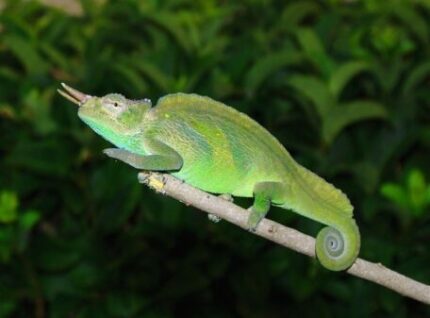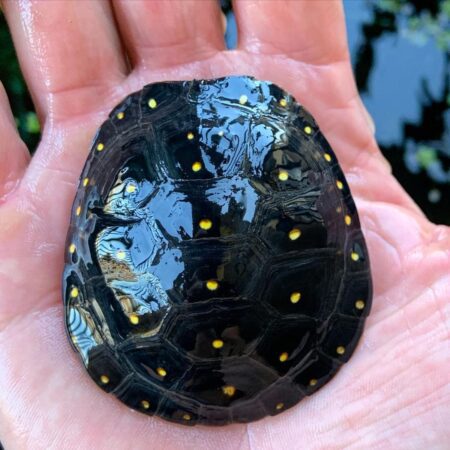Blanding’s turtle is a medium-sized turtle with an average shell length of approximately 7-9 inches and a maximum length of 10 inches. A major feature that distinguishes this turtle from other species is its distinctive bright, solid yellow chin and throat.
Life History
The Blanding’s turtle is a long-lived species, with the oldest known individual reaching over 83 years of age. In New York, the species does not breed until it reaches at least 18 years of age, with some individuals not mating until they are 22 years old. Mating mostly occurs in April and early May, with nesting beginning in early June and lasting throughout the month. The clutch size, or number of eggs laid per female, varies across its range. In New York, the clutch size ranges from 4-18 eggs with an average of 10. Hatchlings emerge from August to October.
The Blanding’s turtle is a shy turtle. When alarmed or approached, it may plunge into water and remain on the bottom for hours. If away from water, the turtle will hide in its shell. It is very gentle and almost never bites. It is a very agile swimmer.
The Blanding’s turtle overwinters near or under water, in mud or under vegetation or debris where it will not freeze. During the nesting season, a female Blanding’s turtle may be found more than a half mile from where she spent the winter. The Blanding’s turtle is also known to estivate (spend a hot or dry period in a long state of dormancy) in leaf litter in uplands around wetlands. It is omnivorous, eating crustaceans and other invertebrates, fish, plants, and carrion (dead animals). It is even capable of catching live minnows.
Distribution and Habitat
This species’ range centers around the Great Lakes and extends from central Nebraska and Minnesota eastward through southern Ontario and the south shore of Lake Erie as far east as Northern New York. A few isolated populations are in southeastern New York (Dutchess County), eastern New York (Saratoga County), New England, and Nova Scotia. Recent investigations in Northern New York report the range of this turtle to be primarily in the Thousand Island region along the St. Lawrence River. In this region, it is found in isolated coves and weedy bays, and further inland in shallow, marshy waters and ponds. It does not commonly occur in the main channel of rivers. Significant populations also occur from the westernmost reaches of St. Lawrence County to Massena, New York. Away from the St. Lawrence River, the turtle can be found in shrubby wetlands dominated by woody vegetation such as buttonbush and willow.
In all areas where Blanding’s turtles are found, vernal (temporary) pools and emergent wetlands are also important parts of Blanding’s turtle habitat, as are sandy soils in uplands that the turtles use for nesting.
Status
A major problem facing the Blanding’s turtle in New York State is the destruction of its nesting and wetland habitats from the construction of housing developments, shoreline properties, and other summer recreation facilities. Roads that cross turtle migration routes between wetlands and ponds where turtles hibernate and upland areas where turtles nest are particularly hazardous to the species, as vehicle strikes are common. Loss of adult females by vehicle strikes is likely the most significant cause of population declines across the species’ range. Since Blanding’s turtles mature late and their populations depend on adults reproducing throughout their relatively long lifespan, the loss of even a single female can have a major impact on a population.
Management and Research Needs
Researchers from DEC and partner organizations are conducting field surveys to better define the range of this species in New York and to estimate population sizes and trends. They are using mark/recapture and radio telemetry techniques to further define turtles’ daily and seasonal movements, habitat use, and nest site selection. Researchers are protecting selected nesting sites from predation in several areas where predators such as raccoons and skunks routinely dig up nests. They are also monitoring new, experimentally-created nesting areas that females can easily access without crossing roads. The monitoring efforts will help researchers determine if the created nesting areas are minimizing threats to nesting females as they move to and from nest sites.
Blanding’s Turtle Conservation Plan
All conservation work mentioned above follows the objectives identified in the Conservation Plan for Populations of the Blanding’s Turtle (PDF). The plan provides basic information about the turtle’s natural history and biology; identifies conservation goals, objectives, and strategies; and lists actions that will help achieve self-sustaining populations of the species in New York.













Reviews
There are no reviews yet.